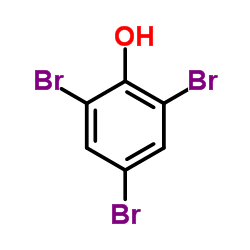2,4,6-Tribromophenol

2,4,6-Tribromophenol structure
|
Common Name | 2,4,6-Tribromophenol | ||
|---|---|---|---|---|
| CAS Number | 118-79-6 | Molecular Weight | 330.799 | |
| Density | 2.4±0.1 g/cm3 | Boiling Point | 286.8±0.0 °C at 760 mmHg | |
| Molecular Formula | C6H3Br3O | Melting Point | 90-94 °C(lit.) | |
| MSDS | Chinese USA | Flash Point | 109.7±25.9 °C | |
| Symbol |


GHS07, GHS09 |
Signal Word | Warning | |
|
Concurrent degradation of tetrabromobisphenol A byOchrobactrumsp. T under aerobic condition and estrogenic transition during these processes
Ecotoxicol. Environ. Saf. 104 , 220-5, (2014) The effect of concurrent degradation of tetrabromobisphenol A (TBBPA) by the strain Ochrobactrum sp. T under aerobic condition was investigated. The results demonstrated that four extra energy source-addition systems still followed pseudo-first order kinetics... |
|
|
Self-Assembly of a Tripod Aromatic Rod into Stacked Planar Networks.
Chemistry 21 , 11836-42, (2015) Threefold symmetric rigid-core molecules with an internally grafted poly(ethylene oxide) (PEO) chain were synthesized, and their self-assembled structures were characterized using differential scanning calorimetry, TEM, and 1D and 2D X-ray scatterings in the ... |
|
|
Structural and kinetic study of an internal substrate binding site in dehaloperoxidase-hemoglobin A from Amphitrite ornata.
Biochemistry 52(14) , 2427-39, (2013) X-ray crystal structures of dehaloperoxidase-hemoglobin A (DHP A) from Amphitrite ornata soaked with substrate, 2,4,6-tribromophenol (2,4,6-TBP), in buffer solvent with added methanol (MeOH), 2-propanol (2-PrOH), and dimethyl sulfoxide (DMSO) reveal an intern... |
|
|
Comparison of PoraPak Rxn RP and XAD-2 adsorbents for monitoring dissolved hydrophobic organic contaminants.
Environ. Monit. Assess. 186(11) , 7565-77, (2014) Accurate determination of the levels of dissolved hydrophobic organic contaminants (HOCs) is an important step in estimating the dynamics of their inputs and losses in aqueous systems. This study explores an alternative method for efficiently sampling dissolv... |
|
|
Biodegradation of brominated aromatics by cultures and laccase of Trametes versicolor.
Chemosphere 76(6) , 826-32, (2009) 2-Bromophenol (1), 4-bromophenol (2), 2,4-dibromophenol (3), 2,6-dibromophenol (4), 2,4,6-tribromophenol (5) and tetrabromobisphenol A (6) (1 mM each) added to growing submerged cultures of Trametes versicolor CCBAS 612 were eliminated by 65-85% from the cult... |
|
|
Kinetic bromine isotope effect: example from the microbial debromination of brominated phenols.
Anal. Bioanal. Chem 405(9) , 2923-9, (2013) The increasing use of kinetic isotope effects for environmental studies has motivated the development of new compound-specific isotope analysis techniques for emerging pollutants. Recently, high-precision bromine isotope analysis in individual brominated orga... |
|
|
Improved approach for analyzing bromophenols in seafood using stable isotope dilution analysis in combination with SPME.
J. Agric. Food Chem. 56(18) , 8248-54, (2008) An analytical method for the measurement of five naturally occurring bromophenols of sensory relevance in seafood (barramundi and prawns) is presented. The method combines simultaneous distillation-extraction followed by alkaline back extraction of a hexane e... |
|
|
Mechanism and direct kinetics study on the homogeneous gas-phase formation of PBDD/Fs from 2-BP, 2,4-DBP, and 2,4,6-TBP as precursors.
Environ. Sci. Technol. 45(5) , 1917-25, (2011) This study investigated the homogeneous gas-phase formation of polybrominated dibenzo-p-dioxin/dibenzofurans (PBDD/Fs) from 2-BP, 2,4-DBP, and 2,4,6-TBP as precursors. First, density functional theory (DFT) calculations were carried out for the formation mech... |
|
|
Potent alpha-glucosidase inhibitors purified from the red alga Grateloupia elliptica.
Phytochemistry 69(16) , 2820-5, (2008) Diabetes mellitus is a most serious and chronic disease whose incidence rates are increasing with incidences of obesity and aging of the general population over the world. One therapeutic approach for decreasing postprandial hyperglycemia is to retard absorpt... |
|
|
Distribution and formation of chlorophenols and bromophenols in marine and riverine environments.
Chemosphere 77(4) , 552-8, (2009) To understand the distribution and formation of chlorophenols (CPs) and bromophenols (BPs), we analyzed water and sediment samples collected from the riverine areas and the marine environments near a nuclear power plant (NPP) in Korea. In the seawater, only B... |